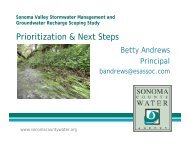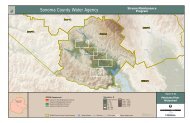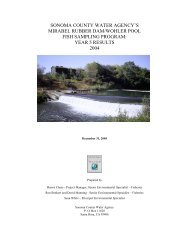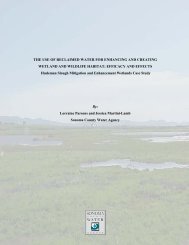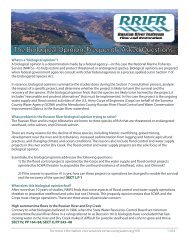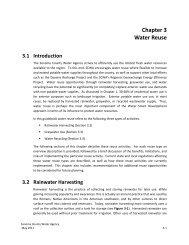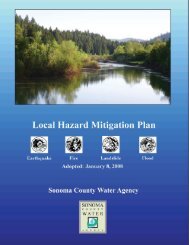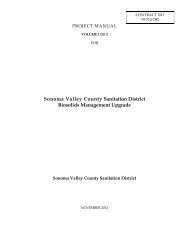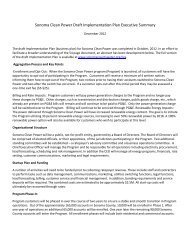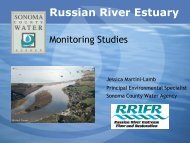Hydrography of the Russian River Estuary - Sonoma County Water ...
Hydrography of the Russian River Estuary - Sonoma County Water ...
Hydrography of the Russian River Estuary - Sonoma County Water ...
You also want an ePaper? Increase the reach of your titles
YUMPU automatically turns print PDFs into web optimized ePapers that Google loves.
Preliminary biochemical oxygen demand (BOD) measurements in <strong>the</strong> <strong>Russian</strong> <strong>River</strong><br />
estuary were obtained by Tamminga and Largier (2009) and found to be consistent with<br />
drawdown <strong>of</strong> DO levels over <strong>the</strong> course <strong>of</strong> a week. In Figure 3.26, data from nearbottom<br />
sondes maintained by SCWA prior to 2009 were plotted as a function <strong>of</strong> time<br />
(i.e., time since bottom water was trapped at depth and isolated from re-oxygenation).<br />
Typical uptake rates reduce DO from 8mg/L in about a week. However, in most cases<br />
near-bottom anoxia is delayed or prevented, presumably by <strong>the</strong> penetration <strong>of</strong> some<br />
light to drive photosyn<strong>the</strong>sis in <strong>the</strong>se deeper waters.<br />
Figure 3.26. Daily average levels <strong>of</strong> dissolved oxygen for events monitored by SCWA<br />
oxygen sondes during closure events prior to 2009 (Tamminga & Largier 2009).<br />
While near-bottom waters at Paddyʼs Rock (and nearby pools like Bridgehaven) were<br />
already hypoxic by <strong>the</strong> time <strong>of</strong> closure (following several days <strong>of</strong> drawdown while<br />
trapped during muted tides), <strong>the</strong> remainder <strong>of</strong> <strong>the</strong> mid/outer estuary was oxygenated at<br />
<strong>the</strong> time <strong>of</strong> closure (Figure 3.24). However, with <strong>the</strong> formation <strong>of</strong> a trapped layer <strong>of</strong><br />
dense saline water throughout <strong>the</strong> estuary, near-bottom DO levels decreased so that<br />
hypoxia was observed at depth throughout <strong>the</strong> mid/outer estuary within a week <strong>of</strong><br />
closure. While DO pr<strong>of</strong>ile data from <strong>the</strong> inner estuary is lacking, it is expected that<br />
hypoxic conditions developed within a week <strong>of</strong> <strong>the</strong> trapping <strong>of</strong> a saline lower layer at<br />
Heron Rookery and Freezeout Creek (as described in section 3.3.2 above) – this is<br />
seen in SCWA sonde data. This hypoxia is evident at Heron Rookery on 26 September,<br />
persisting through <strong>the</strong> remainder <strong>of</strong> <strong>the</strong> closure period (Figure 3.27).<br />
43




